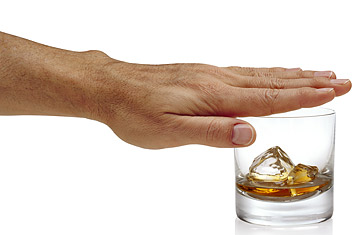
Somewhere out there may be a martini with your name on it. That's not such a bad thing if you drink occasionally and know when enough is enough. But if you drink too much — particularly if you're inclined to get behind the wheel afterwards — a martini with your name on it can be like a bullet with your name on it. In that case, the best defense against downing a shot could turn out to be getting a shot; that, at least, is the thinking behind a new study of monthly injections to battle alcohol abuse. (See the Top 10 Medical Breakthroughs of 2008.)
Drinking too much is a deadly game any time of year, but it's particularly so during the holidays, when alcohol-fueled parties abound and even moderate social drinkers may indulge too heavily. That's the reason 40% of all road deaths during the Christmas and New Years season involve at least one alcohol-impaired driver, compared to 28% the rest of the year. Those numbers ought literally to be sobering, but for some drinkers — full-blown alcoholics in particular — they're not.
One answer for those trying to kick the habit is naltrexone, a once-a-day prescription medication that works in the brain to curb the urge to drink and reduce the amount consumed if drinkers do give into the craving. But there's one difficulty with naltrexone: In order for the pill to work, you have to take it — essentially making a chemical commitment to sobriety every day. That's not so easy for people who deny they have a problem or who know they do but are nonetheless looking forward to the annual office bash. "Part of the traditional problem with naltrexone has been that people just don't take it," says David Rosenbloom, a substance abuse specialist at the Boston School of Public Health and director of the addiction prevention and policy group Join Together. (See pictures of Denver, Beer Country.)
In 2006, The Food and Drug Administration sought to address that problem, approving a new form of naltrexone in which tiny grains of the drug are coated in a biodegradable polymer. Inject a dose of this reformulated stuff, and the coating will dissolve slowly, releasing just enough drug for just enough time to keep you off the sauce for a full month. If one of those months is the holiday season, could the strategy save lives? The new study says that the answer is yes.
Working with the manufacturer of the slow-release naltrexone, Dr. Sandra Lapham of the Behavioral Health Research Center of the Southwest, in Albuquerque, New Mexico, reanalyzed data from earlier studies, teasing out findings that specifically focused on the drug's effectiveness during 10 U.S. holidays. Comparing patients who received the naltrexone shots to those who received placebos, she found a reduction in the number of days the subjects drank and — on those days they slipped — in the number of drinks they consumed, with a smaller percentage of sessions classified as heavy drinking sessions (five or more drinks for men and four or more for women). These results were actually consistent throughout the year, but the fact that they didn't flag during the holidays proved the benefits of the drug in a particularly high-risk season. "This was an opportunistic look at a period of time in the year known to be associated with high levels of relapse," says Rosenbloom.
The study clearly supports the idea of a seasonal injection or two, but if slow-release naltrexone works as well as it does, does this call the value of the daily doses into question? When you're dealing with patients who are struggling with as powerful a temptation as alcohol, is there any argument against a treatment that requires them to reaffirm their commitment just 12 times a year instead of 365 times? "No argument at all," says Rosenbloom. If you're battling alcohol addiction, that simple answer may be the best holiday gift of all.
See the Year in Health, from A to Z.
See TIME's Person of the Year, People Who Mattered, and more.
